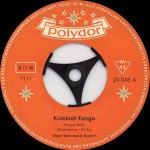Während der zweiten Tangomanie war Berlin eine der Hauptstädte des Tangos [1]. Hier spielten original argentinische Orchester, und auch deutsche Orchester versuchten, die populäre Tangomusik zu kopieren. Die Leute waren verrückt danach und verlangten nach mehr. 1928 wurde sogar ein Tango in Kurt Weills „Dreigroschenoper“ eingebaut [2].
http://www.youtube.com/watch?v=ARfumOj5GLw
Vor allem in Berlin eröffneten große Ballsäle, darunter das „Femina“, mit vier Stockwerken, 400 Tischen für 2000 Gäste und vier Tanzflächen [3, 4]. Die Tische waren sogar mit Telefonen verbunden [5]. In den europäischen Hauptstädten spielten original argentinische Orchester, darunter ein Orchester unter der Leitung eines Bruders von Francisco Canaro, das in „Gaucho“-Kleidung spielte. Die Situation wurde in einem Tango von Friedrich Holländer beschrieben: „Gugg doch nicht immer nach dem Tangogeiger hin“. Das Lied wurde von einigen Sängern vorgetragen, darunter Curt Bois, Leo Monosson und Weintraubs Syncopators.
http://www.youtube.com/watch?v=wAQZO3cGURQ
https://www.youtube.com/watch?v=OvbkFd8YJZ8#t=12
http://www.youtube.com/watch?v=UhZ98wnPcUg
Interessanterweise singt der Komponist Friedrich Hollaender den Refrain im letzten Beispiel persönlich.
Der Gesang beschreibt einen Herrn, der sich darüber beschwert, dass seine Frau/Freundin immer zum Tango-Geiger blickt, der eine Uniformjacke trägt (wie ein Affe…). Hier sind der deutsche Gesang und die englische Übersetzung:
Gugg doch nicht immer nach dem Tangogeiger hin, was ist schon dran an Argentinien ?
Du siehst ja garnicht dass ich auch noch bei dir bin, ich hab doch auch ganz schöne Linien.
Der Junge wirkt auf Dich wohl „spanisch“, jedoch aus Dir macht er sich gar nichts,
Also bitte: Gugg doch nicht immer nach dem Tangogeiger hin, was ist schon dran an Argentinien !
Sicher ist es bloß die olle Uniform, die wirkt wie Chloroform auf jede Frau,
zöge ich mir so ne Affenjacke an, fängt sie mit mir was an, ich weiß genau.
Doch ich verschmähe gottseidank solche Tricks, mich muss man lieben wie ich bin, oder nix,
Wenn sie sich verknallt, bitteschön – mich lässt es kalt.
Don´t always look at the Tango fiddler, what is all about Argentina ?
You don´t notice that I am with you, I am also looking quite handsome.
This guy looks for you really Spanish, but he doesn´t notice you at all.
So please: Don´t always look at the Tango fiddler, what is all about Argentina ?
Surely it is only the old uniform, it works like chloroform for all the women.
If I would wear such a monkey jacket, she would fall in love with me, I am sure.
But I dislike such tricks, I want to be loved like I am – or not at all.
If she falls in love – well I don´t care.
Offenbar hat der Komponist einige Argentinier in besonderen Outfits gesehen (vielleicht das Canaro-Orchester). Darüber hinaus waren die Deutschen etwas neidisch, wussten aber durchaus, dass der Tango aus Argentinien stammt. Im ersten Video sehen Sie Bilder von Curt Bois, und vielleicht erkennen Sie einen von ihnen wieder. Curt Bois spielte 1942 eine kleine Rolle im Film Casablanca, Sie dürften ihn also schon einmal gesehen haben.
Deutsche Orchester versuchten, die argentinische Tango-Spielweise zu kopieren, waren aber meist nicht wirklich erfolgreich. Dafür gibt es zwei Gründe. Selbst im Land, das das Bandonion erfunden hat, waren diese Instrumente in Tanzorchestern nicht vorhanden und wurden, wenn überhaupt, meist durch das Akkordeon ersetzt. Ein weiteres Problem ist die Art und Weise, wie Rhythmus im Orchester erzeugt wird. Eines der wichtigsten Merkmale lateinamerikanischer Musik ist die Tatsache, dass alle Instrumente gemeinsam Rhythmus erzeugen. Für ein europäisches Orchester ist die Rolle von Rhythmus- und Führungsinstrumenten festgelegt und nicht variabel. So wird in späteren Phasen der Rhythmus durch Trommeln erzeugt, und das wesentliche Merkmal des ursprünglichen Tangos wird zu einem militärischen Sumpf kastriert.
Es gab gute Musiker, die den Tango wirklich studiert haben. Einer von ihnen war Juan Llossas, gebürtiger Spanier, der seine Karriere in Lateinamerika begann und in Deutschland (Darmstadt und Berlin) Musik studierte. Dort gründete er sein Spanisch-Argentinisches Tango-Orchester. Dieses Orchester spielte, als 1929 die Femina in Berlin eröffnet wurde [6]. Er wurde der deutsche „Tango-König“ genannt. Hier drei seiner Stücke, das zweite gesungen von Leo Monosson:
http://www.youtube.com/watch?v=-Bqau5DcieI
http://www.youtube.com/watch?v=2lS_JpLWS58
http://www.youtube.com/watch?v=PI-sJwAaTQc
Andere Orchester spielten europäische Kompositionen, hier ein Beispiel von Donna Clara (im Original eine polnische Komposition von Petersburski), hier das Orchester von Marek Weber:
http://www.youtube.com/watch?v=qrazWuIyty8
Aus 1929 hier ein anderes Beispiel von L.Bernauer:
http://www.youtube.com/watch?v=hjjzKVGibcE
und ein weiterer Song von L.Monosson:
http://www.youtube.com/watch?v=6CR1x9TqYRk
Nach dem Zweiten Weltkrieg endete die Zeit der deutschen Tango-Schlager. Einer der letzten war Hazy Osterwalds Kriminal Tango von 1959 [7]:
http://www.youtube.com/watch?v=N7Rg2qCHyuQ
Heute spielen moderne Orchester nostalgische Tangos im Originalstil der 20er Jahre. Ein letztes Beispiel ist das Palastorchester von Max Raabe:
http://www.youtube.com/watch?v=Fj7QM4KzfwE
Viel Spass,
-Richard
Literatur
1 http://de.wikipedia.org/wiki/Deutscher_Tango
2 http://en.wikipedia.org/wiki/The_Threepenny_Opera
3 Birkenstock A, Rüegg H: Tango – Geschichte und Geschichten. DTV, 2001.
4 http://de.wikipedia.org/wiki/Femina-Palast
5 https://anthropologist.wordpress.com/2008/10/29/the-cultural-life-of-berlin-circa-1933/
6 http://de.wikipedia.org/wiki/Juan_Llossas
7 http://en.wikipedia.org/wiki/Kriminaltango

